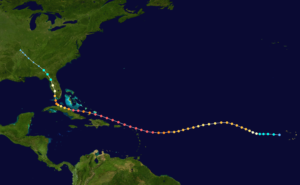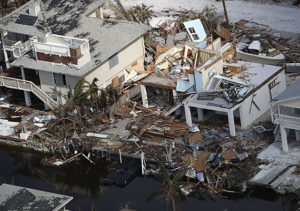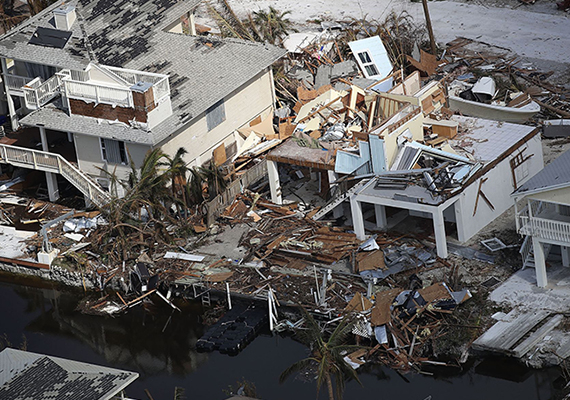- Timeline: Aug 30 – Sept 13, 2017
- Severely Impacted Areas: USVI, Puerto Rico, Georgia, Florida
- Maximum Sustained Winds: 180 mph
- Fatalities: 52 direct (wind-driven debris, storm surge), 82 indirect (heart attack, house fires, vehicle accidents)
- Damages: $64.76 Billion (5th costliest tropical cyclone on record)
Hurricane Irma’s Trek Across the Atlantic
This week marks the anniversary of Hurricane Irma forming and making landfall across the Southern United States. Tropical Storm Irma became a named storm on the 30th of August, 2017. It moved steadily across the Atlantic Ocean at 10-15 mph. A week later, now a Category 5 Hurricane, Irma passed by Puerto Rico narrowly missing it to the north. The storm continued skirting along the northern coasts of the Caribbean Islands including the Dominican Republic and then Cuba. Then, a glancing landfall moment happened along the North Cuban coastline, briefly weakening Irma to a Category 3 Hurricane as it turned north toward Florida.
Throughout Irma’s approach to the US Mainland, forecasts remained uncertain and models were not in agreement. Every update led to questions: would Miami or Orlando would be directly in the path, would the storm would move farther west and trail the Gulf Coast side of Florida, or would it shift a bit more west and come up the Gulf and end up hitting the Florida panhandle? One thing was certain – wherever landfall occurred, winds, rain, and storm surge were going to be affect a lot of people and infrastructure. Hurricane Irma ended up making landfall as a Category 3 Hurricane on September 10th, 2017, just south of Fort Myers along the SW part of Florida’s peninsula.

Hurricane Irma’s path across the Atlantic Ocean (Source: WikiCommons)
Rebuilding Ongoing
While power has been restored and roadways cleared, many areas still see the impacts of these storms. The Florida Keys and much of Florida’s peninsula experienced hurricane force winds, nearly a foot of rain, and around 10ft of storm surge. Cleaning up the wide-spread damage is a daunting undertaking; however, FEMA, charities from around the world, and community efforts came together to assist residents to get their areas back to habitable conditions. By October 1st, much of Key West’s historical district was back in operation and welcoming guests. Nearer the main land, the damage was more extensive. Some businesses and homeowners have chosen not to rebuild and now those that had less significant repairs have vacant lots as neighbors. Each family has to make the best decision for their circumstances and many chose to shift to a new location rather than go through the extensive rebuilding process.

Damaged structures on Ramrod Key, FL after Hurricane Irma passed through the area. (Source: Joe Raedle)
When coming home after a storm, reentering the region, property, and structure safely is important. Ensuring flooding conditions haven’t led to moldy conditions, debris is properly removed, and the structure remains sound are just a few common checks. FEMA and the Insurance Institute for Business & Home Safety shared Safety Guidelines useful to making this process as smooth as possible.
Sources
National Hurricane Center, The Weather Channel, FEMA





One Comment